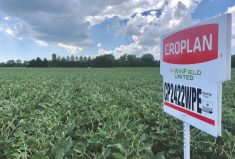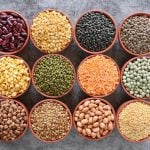Wild oats have reigned as Western Canada’s worst weed for about 40 years, and multiple herbicide resistance and farmers’ reluctance to alter their practices may ensure the title doesn’t change hands in the foreseeable future.
“Based on our surveys, we estimate that over half of the cultivated land in the Prairies — about 36 million acres — is affected by herbicide-resistant wild oats, and a portion of that would be multiple resistant,” says Hugh Beckie, an Agriculture and Agri-Food Canada research scientist specializing in herbicide-resistant plants.
Most of the multiple-resistant wild oats demonstrate Group 1 resistance, but a rising amount of Group 2 resistance is showing up as growers switch from Group 1 herbicides that didn’t work to Group 2s.
Read Also

Agronomists share tips for evaluating new crop products and tech: Pt. 3
With new products, new production practices and new technology converging on the agriculture industry at a frenetic pace in recent…
The first documented case of Group 1-resistant wild oats was reported in 1990 in Manitoba near Swan River. It wouldn’t be very long before multiple-resistant wild oats would be discovered in the northwestern region of the province. These were the first wild oats documented with three-way group resistance, with populations resistant to Group 1, Group 2 plus Group 25 herbicides.
Herbicide selection pressure led farmers down this path to multiple-resistant wild oats.
“Selection pressure just means you apply the same herbicide over and over again,” explains Neil Harker, a weed science specialist with Agriculture Canada, adding the resistant biotype has always been there. “If the resistant biotype is one in 100 million, it takes a few years to select that out of all the susceptibles. The more you put on herbicides, the quicker you get there.”
Unfortunately, many have tried to tackle a herbicide problem with more herbicides.
“Growers usually try and find any Group 1 or 2 that still works,” says Beckie. “Clethodim we know is a low-risk Group 1, so they’re trying that, or Axial, which is a ‘den’ Group 1 herbicide. Sometimes that works. By trial and error, they’re trying to see if there are still effective herbicides within those groups.”
Some try to minimize the viability of immature wild oats by applying a pre-harvest glyphosate.
Also emerging as a solution are some old chemistries.
“I always recommend growers don’t forget some of these old herbicides liked Edge or trifluralins, the Groups 3s, because even in Australia, they’re relying on those old chemistries as the backbone of their resistance management,” says Beckie. “We still have residual herbicides, even in our age of direct seeding, that need to be looked at.”
“We should put some emphasis on bringing some of them back,” agrees Harker. “For those unwilling to switch to cultural management strategies, it would at least bring some diversity in herbicide use.”
When it comes right down to it, there aren’t a great many herbicide options left for grass weeds like wild oats.
“It’s not like broadleaf weed resistance management where tank mixing is what I recommend,” says Beckie. “If you’re mixing Group 1 and Group 2, they’re both high-risk herbicides, so I’ve never advocated that practice because you may select for resistance mechanisms in the population — like enhanced metabolism that confers this broad cross resistance across both groups.”
Ultimately, though, farmers need to wean themselves off their ag chemical dependencies.
“The way that you slow down selection pressure for resistance is to be less dependent on herbicides,” says Harker.
A more integrated approach
Much less popular but more likely to minimize wild oats issues are preventive and cultural weed control practices. But it’s not an easy pitch.
Studies have found efficacy in implementing higher seeding rates, planting winter cereals like winter wheat, fall rye and winter triticale, and perennial forages such as alfalfa.
“Some of those practices when used together, even without wild oat herbicides, can be very effective on wild oats without putting on any selection pressure,” says Harker.
There’s mixed acceptance of higher seeding rates.
“I know it’s a tough sell for pulse crops or canola because of the seed price, but for bin-run cereals, we always recommend that you try and use the upper recommended seeding rate because it’s a natural biological control,” says Beckie. (Harker adds that those more willing to up their seeding rates tend to be more progressive and therefore more likely to use certified seed.)
Studies have shown higher crop density is one of the more consistent cultural weed management practices that are effective in reducing weed populations, Beckie notes.
Also effective are fall-seeded crops. If the plant gets established well enough, it’ll be so far ahead of wild oats in the spring that a farmer may not even need to apply wild oat herbicides, and in turn minimize the selection pressure.
“The crop outcompetes the wild oat, and that’s one of the advantages to growing those crops,” says Harker. “So not only do you have less cost from not having to apply a wild oat herbicide, you’ve put on no selection pressure for herbicide resistance.”
But farmers went in the wrong direction when it came to planting last fall. Most glaring was Prairie winter wheat seedings, which plunged to 665,000 acres from the previous year’s 1.13 million.
While forages are also well-established weed fighters, they aren’t a particularly favoured option either.
“Maybe in parts of Manitoba you see (alfalfa planted) more commonly, but when you get into Saskatchewan and Alberta, growers don’t want to be bothered with including a two- or three-year stand of alfalfa, unless they have livestock or they can sell it. It’s always been a challenge that way,” says Beckie.
“People are losing diversity in their cropping systems,” says Harker. “Some people grow continuous canola, some people grow canola/wheat, but they’re not putting forages in their rotation, they’re not putting winter cereals as much as they should. That’s going to be a problem in the long term. It won’t be a problem in the short term because right now you get away with it as you don’t have the dominant resistance yet, but some guys are starting to get it.”
More diverse rotations wouldn’t hurt either. “The most popular rotation on the Prairies now is canola/wheat, canola/wheat. People have been doing that over and over again to try to maximize their short-term profitability, but that puts a lot of pressure on wild oats and other weeds when you use the same herbicides over and over,” says Harker.
Farmers also should look at planting tall cultivars or just simply more competitive cultivars.
“Some growers know what cultivars do better in their own area. There isn’t really a prototype cultivar that is better than all the rest unless you know that there’s one that comes up earlier and grows faster early — that’s what you’re looking for,” says Harker.
Land that becomes infested with multiple resistance can take a long time to recover, he warns.
“We’ve had cases where people have gone back 20 years later after resistance happened and it’s still there — same level.”
And that ultimately impacts the value of your land. “There are cases in the southern U.S. where they have huge resistance issues where the land value is significantly degraded,” says Harker, who indicates less productive land is bound to be less enticing to a prospective buyer. “Who wants to farm there?”
Nevertheless, there remains hesitation to adopt alternative practices to combating multiple resistance.
“Unfortunately, farmers don’t embrace things until they’re forced to in many cases,” says Harker. “A lot of people believe there’ll just be a new herbicide solution. ‘We may lose these herbicides that we use now, but the herbicide industry will come up with something new.’ And there’s little or no evidence to show that that’s the case.”
Future grim?
Both weed scientists believe that it’s inevitable the situation will only get worse, especially with no new herbicide chemistries in the pipeline.
“There hasn’t really been a new herbicide mode of action or a major mode-of-action group introduced in the last 20 years,” notes Harker. “So these herbicides, you could almost call them a non-renewable resource, because we just don’t seem to be getting a lot more new ones.”
Beckie thinks that in the interim, glyphosate and glufosinate will be two of the mainstay herbicides to slow down problems. Considering stacked traits in the pipeline, Beckie says Liberty and Roundup have helped keep a lid on the wild oat resistance problem because of their different modes of action.
“In that way, I think they’ll be very effective, either with the single trait Roundup Ready alone or the Liberty alone or stacked. I think that’s one example where it’s demonstrated to be really the cornerstone of multiple-resistant wild oat management,” Beckie says.
But he also predicts there will be more multiple-resistant wild oats populations recorded across all three Prairie provinces, pointing out that surveys since the 1990s have found the weed is increasing in its distribution and abundance. And that will continue to adversely affect profitability, crop yields, quality and herbicide costs.
“My outlook is we’re going to have more and more of this until people feel like they’re forced to do something different,” adds Harker. When it comes to grower resistance, it hasn’t been a club exclusive to Prairie growers. “People also say they don’t want to do anything like pull a chaff cart or buy a Harrington seed destructor. Well, the people in Australia didn’t want to do that either, but now they are because they have to.”
“People believe there’ll just be a new herbicide,” says Harker. “There’s little or no evidence to show that that’s the case.”
















